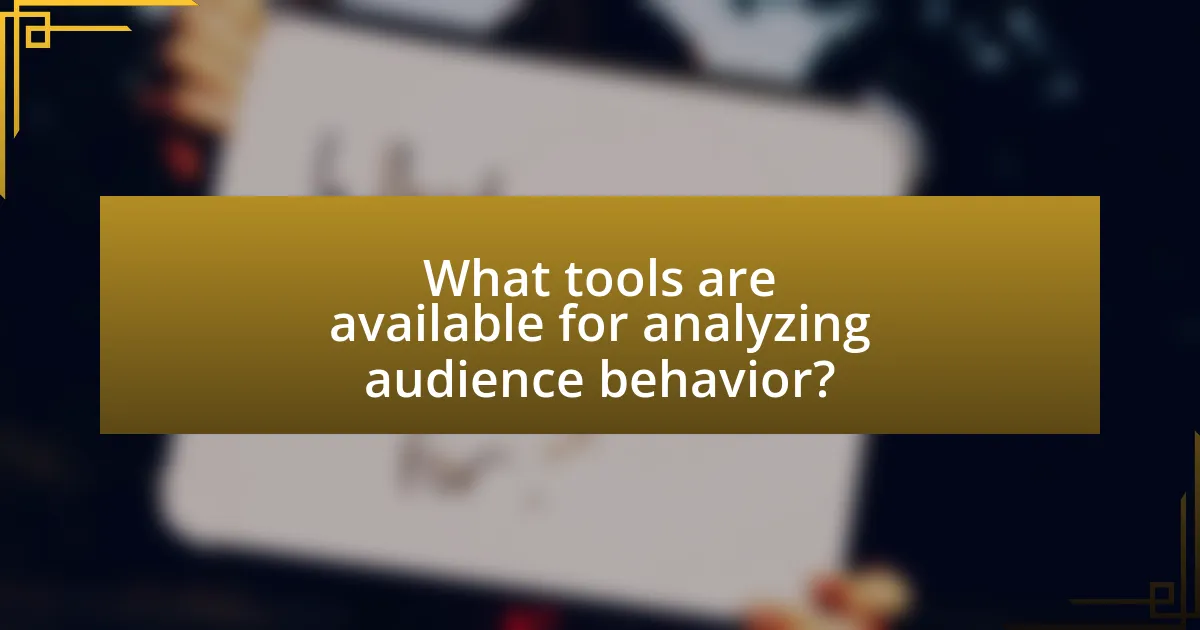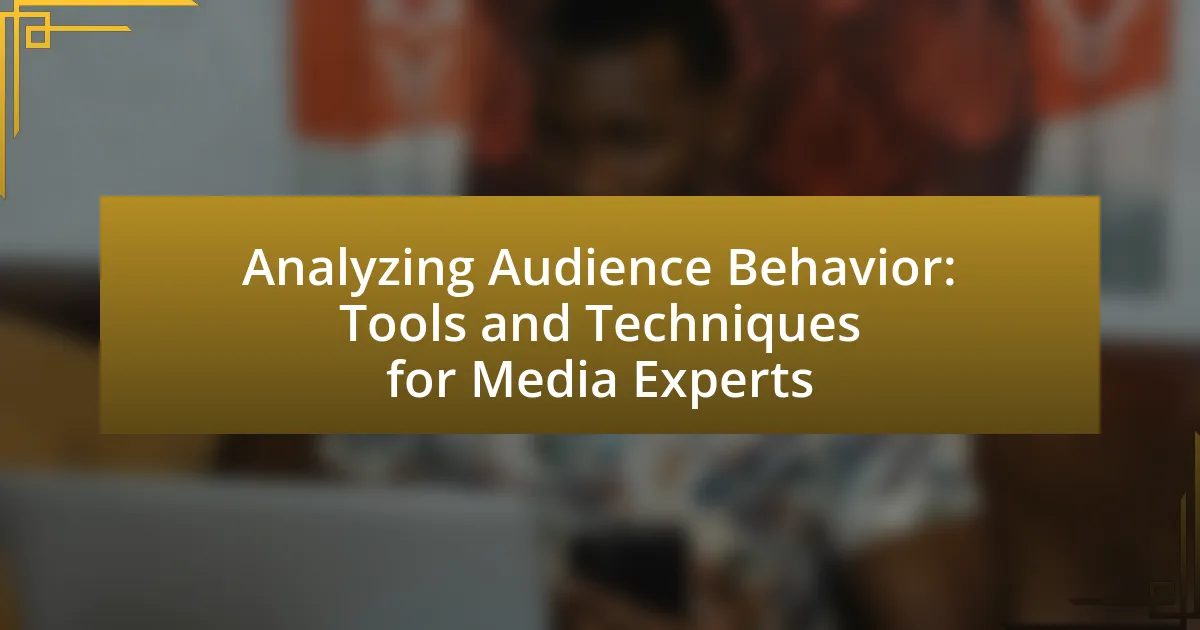Audience Behavior Analysis is a systematic approach to understanding how audiences interact with media content, platforms, and advertisements. This article explores the significance of audience behavior insights for media experts, detailing how these insights can enhance content effectiveness and inform media strategies. Key components of audience behavior analysis, such as demographic profiling, psychographic analysis, and engagement metrics, are discussed, along with the tools and techniques available for effective analysis. The article also addresses the challenges faced in audience behavior analysis, including data privacy concerns and the importance of continuous improvement in analysis techniques.

What is Audience Behavior Analysis?
Audience Behavior Analysis is the systematic study of how audiences interact with media content, platforms, and advertisements. This analysis involves collecting and interpreting data on audience preferences, engagement patterns, and consumption habits to inform media strategies. For instance, research indicates that 70% of marketers believe audience behavior insights significantly enhance their content effectiveness, demonstrating the importance of understanding audience dynamics in media planning and execution.
Why is understanding audience behavior important for media experts?
Understanding audience behavior is crucial for media experts because it enables them to tailor content effectively to meet the preferences and needs of their target demographic. By analyzing audience behavior, media professionals can identify trends, engagement patterns, and content consumption habits, which directly influence content strategy and marketing efforts. For instance, a study by Nielsen found that 70% of consumers prefer personalized content, highlighting the importance of audience insights in driving engagement and satisfaction. This understanding allows media experts to optimize their messaging, improve audience retention, and ultimately enhance the effectiveness of their campaigns.
What insights can audience behavior analysis provide?
Audience behavior analysis provides insights into audience preferences, engagement patterns, and content effectiveness. By examining metrics such as viewing time, interaction rates, and demographic data, media experts can identify which content resonates most with specific audience segments. For instance, a study by Nielsen found that understanding audience behavior can lead to a 20% increase in viewer retention when content is tailored to audience preferences. This analysis enables targeted marketing strategies and enhances content development, ultimately driving higher engagement and satisfaction.
How does audience behavior impact media strategies?
Audience behavior significantly impacts media strategies by informing content creation, distribution channels, and engagement tactics. Understanding how audiences consume media—such as their preferred platforms, peak usage times, and content types—allows media strategists to tailor their approaches effectively. For instance, a study by Nielsen in 2021 revealed that 70% of consumers prefer personalized content, indicating that strategies must adapt to individual preferences to enhance engagement. Additionally, audience feedback and interaction patterns can guide real-time adjustments in campaigns, ensuring that media strategies remain relevant and effective.
What are the key components of audience behavior analysis?
The key components of audience behavior analysis include demographic profiling, psychographic analysis, behavioral tracking, and engagement metrics. Demographic profiling involves collecting data on age, gender, income, and education to understand the audience’s characteristics. Psychographic analysis examines the audience’s interests, values, and lifestyles, providing deeper insights into their motivations. Behavioral tracking focuses on monitoring audience interactions with content, such as viewing habits and response patterns, which helps identify preferences. Engagement metrics measure the level of interaction, such as likes, shares, and comments, indicating how effectively content resonates with the audience. These components collectively enable media experts to tailor content strategies and improve audience engagement.
What types of data are collected in audience behavior analysis?
Audience behavior analysis collects various types of data, including demographic information, engagement metrics, viewing habits, and feedback. Demographic information encompasses age, gender, location, and income level, which helps in understanding the audience’s profile. Engagement metrics involve data on how often and for how long audiences interact with content, such as click-through rates and time spent on a page. Viewing habits track patterns in content consumption, including preferred platforms and times of access. Feedback data includes surveys, comments, and ratings, providing insights into audience preferences and satisfaction levels. Collectively, these data types enable media experts to tailor content and strategies effectively.
How is audience segmentation performed?
Audience segmentation is performed by dividing a target audience into distinct groups based on shared characteristics. This process typically involves analyzing demographic data, psychographic profiles, behavioral patterns, and geographic locations to identify segments that exhibit similar preferences or needs. For instance, marketers often utilize tools like surveys, social media analytics, and customer relationship management (CRM) systems to gather relevant data, which helps in creating tailored marketing strategies for each segment. Research indicates that effective audience segmentation can lead to a 760% increase in revenue, demonstrating its significance in optimizing marketing efforts.

What tools are available for analyzing audience behavior?
Tools available for analyzing audience behavior include Google Analytics, social media analytics platforms like Facebook Insights and Twitter Analytics, and survey tools such as SurveyMonkey. Google Analytics provides detailed insights into website traffic and user engagement, allowing media experts to track audience demographics and behavior patterns. Social media analytics platforms offer metrics on user interactions, engagement rates, and audience growth, which help in understanding audience preferences. Survey tools enable direct feedback from audiences, providing qualitative data that complements quantitative analytics. These tools collectively enhance the understanding of audience behavior, enabling targeted content strategies.
How do analytics platforms contribute to audience behavior analysis?
Analytics platforms contribute to audience behavior analysis by collecting, processing, and interpreting data on user interactions across various channels. These platforms utilize metrics such as page views, click-through rates, and user demographics to provide insights into audience preferences and engagement patterns. For instance, Google Analytics reports that businesses using data-driven marketing strategies can increase their ROI by up to 5-8 times, demonstrating the effectiveness of analytics in understanding audience behavior. By leveraging these insights, media experts can tailor content and marketing strategies to better meet audience needs, ultimately enhancing user experience and engagement.
What features should media experts look for in analytics tools?
Media experts should look for features such as real-time data processing, audience segmentation, and customizable reporting in analytics tools. Real-time data processing allows for immediate insights into audience behavior, enabling timely decision-making. Audience segmentation helps in understanding different demographics and tailoring content accordingly. Customizable reporting provides flexibility in analyzing specific metrics that align with strategic goals. These features enhance the ability to track engagement, measure campaign effectiveness, and optimize content strategies based on audience preferences.
How do social media analytics differ from traditional analytics?
Social media analytics differ from traditional analytics primarily in their focus on real-time engagement and sentiment analysis. While traditional analytics often emphasizes historical data and metrics such as sales figures or website traffic, social media analytics prioritize user interactions, comments, shares, and likes, providing insights into audience sentiment and behavior as they happen. For instance, a report by Sprout Social indicates that 79% of consumers expect brands to respond to their social media inquiries within 24 hours, highlighting the importance of timely engagement in social media analytics. This real-time aspect allows brands to adapt their strategies quickly based on audience feedback, unlike traditional analytics, which may rely on slower, retrospective data analysis.
What role does qualitative research play in understanding audience behavior?
Qualitative research plays a crucial role in understanding audience behavior by providing in-depth insights into the motivations, attitudes, and emotions of individuals. This research method allows media experts to gather rich, descriptive data through interviews, focus groups, and observations, which helps to uncover the underlying reasons behind audience preferences and actions. For instance, a study published in the Journal of Advertising Research found that qualitative insights can reveal how cultural contexts influence consumer behavior, thereby enabling marketers to tailor their strategies effectively. By capturing the nuances of audience experiences, qualitative research enhances the ability to predict and respond to audience needs, ultimately leading to more effective communication and engagement strategies.
What methods are used in qualitative research for audience analysis?
Qualitative research for audience analysis employs methods such as interviews, focus groups, and ethnographic studies. Interviews allow researchers to gather in-depth insights from individuals about their perceptions and experiences, while focus groups facilitate discussions among participants to explore collective attitudes and behaviors. Ethnographic studies involve observing audiences in their natural environments, providing context to their interactions with media. These methods are validated by their widespread use in academic and industry research, demonstrating their effectiveness in understanding audience motivations and preferences.
How can focus groups enhance audience insights?
Focus groups enhance audience insights by facilitating in-depth discussions that reveal participants’ attitudes, beliefs, and motivations. This qualitative research method allows media experts to gather nuanced feedback on content, messaging, and branding, which quantitative methods may overlook. For instance, a study by Krueger and Casey (2015) highlights that focus groups can uncover underlying emotions and perceptions, providing richer context to audience data. By analyzing these discussions, media professionals can tailor their strategies to better align with audience preferences, ultimately leading to more effective communication and engagement.

What techniques can media experts use to analyze audience behavior effectively?
Media experts can effectively analyze audience behavior using techniques such as data analytics, surveys, focus groups, and social media monitoring. Data analytics allows experts to interpret large datasets to identify trends and patterns in audience engagement, while surveys provide direct feedback from the audience regarding their preferences and behaviors. Focus groups facilitate in-depth discussions that reveal insights into audience motivations and perceptions. Social media monitoring enables experts to track real-time audience interactions and sentiments, providing a comprehensive view of audience behavior across various platforms. These techniques are validated by industry practices, demonstrating their effectiveness in understanding and responding to audience needs.
How can A/B testing improve audience engagement?
A/B testing can improve audience engagement by allowing media experts to compare two versions of content to determine which one resonates more with the audience. This method provides data-driven insights into user preferences, enabling the optimization of content, design, and messaging. For instance, a study by Optimizely found that A/B testing can lead to conversion rate increases of up to 49% when the winning variant is implemented. By systematically testing different elements, such as headlines or images, media experts can refine their strategies based on actual audience behavior, ultimately enhancing engagement levels.
What are the best practices for conducting A/B tests?
The best practices for conducting A/B tests include defining clear objectives, ensuring a sufficient sample size, randomizing participants, and analyzing results with statistical significance. Clear objectives guide the test design and focus on specific metrics, such as conversion rates or user engagement. A sufficient sample size is crucial to achieve reliable results; for instance, a sample size calculator can help determine the number of participants needed based on expected effect size and desired power. Randomization minimizes bias by ensuring that each participant has an equal chance of being assigned to either group. Finally, analyzing results with statistical significance, typically using a p-value threshold of 0.05, confirms whether observed differences are likely due to the changes made rather than random variation. These practices enhance the validity and reliability of A/B testing outcomes.
How do results from A/B testing inform content strategy?
Results from A/B testing inform content strategy by providing data-driven insights into audience preferences and behaviors. A/B testing allows media experts to compare two or more variations of content to determine which performs better in terms of engagement, conversion rates, or other key performance indicators. For instance, a study by Optimizely found that companies using A/B testing saw conversion rate improvements of up to 30%. This empirical evidence enables content strategists to make informed decisions about which content elements resonate most with their audience, ultimately leading to more effective and targeted content strategies.
What is the significance of tracking audience engagement metrics?
Tracking audience engagement metrics is significant because it provides insights into how effectively content resonates with the target audience. By analyzing these metrics, media experts can identify trends, preferences, and behaviors that inform content strategy and improve audience retention. For instance, a study by HubSpot found that companies that prioritize audience engagement see a 63% higher rate of customer retention. This data underscores the importance of understanding engagement levels to optimize content delivery and enhance overall audience experience.
Which engagement metrics are most relevant for media experts?
The most relevant engagement metrics for media experts include audience reach, engagement rate, click-through rate (CTR), and conversion rate. Audience reach measures the total number of unique users who see content, providing insight into potential visibility. Engagement rate, calculated as the total interactions (likes, shares, comments) divided by total followers or impressions, indicates how effectively content resonates with the audience. Click-through rate (CTR) reflects the percentage of users who click on a link compared to those who view the content, highlighting the effectiveness of calls to action. Conversion rate measures the percentage of users who complete a desired action, such as signing up or making a purchase, demonstrating the ultimate effectiveness of media strategies. These metrics are essential for evaluating content performance and audience interaction, enabling media experts to refine their strategies based on data-driven insights.
How can engagement metrics guide content creation?
Engagement metrics can guide content creation by providing data-driven insights into audience preferences and behaviors. By analyzing metrics such as likes, shares, comments, and time spent on content, creators can identify what resonates with their audience. For instance, a study by HubSpot found that content with higher engagement rates typically aligns with audience interests, leading to increased reach and effectiveness. This data allows content creators to tailor their strategies, focusing on topics and formats that drive interaction, ultimately enhancing audience satisfaction and loyalty.
What are the common challenges in audience behavior analysis?
Common challenges in audience behavior analysis include data privacy concerns, data integration issues, and the dynamic nature of audience preferences. Data privacy concerns arise from regulations like GDPR, which restrict how audience data can be collected and analyzed. Data integration issues occur when combining data from multiple sources, leading to inconsistencies and gaps in understanding audience behavior. Additionally, the dynamic nature of audience preferences makes it difficult to maintain accurate and relevant insights, as trends can shift rapidly, requiring continuous adaptation of analysis methods.
How can data privacy concerns affect audience analysis?
Data privacy concerns can significantly hinder audience analysis by limiting the availability and accuracy of data collected from users. When individuals are apprehensive about how their personal information is used, they may opt out of data collection mechanisms, such as cookies or surveys, leading to incomplete datasets. For instance, a 2021 survey by the Pew Research Center found that 81% of Americans feel they have little to no control over the data collected about them, which directly impacts the quality of insights that media experts can derive from audience behavior. Consequently, this lack of comprehensive data can result in skewed analysis, making it challenging for media professionals to tailor content effectively or understand audience preferences accurately.
What strategies can mitigate biases in audience data?
To mitigate biases in audience data, employing diverse data sources and implementing algorithmic fairness techniques are essential strategies. Utilizing multiple data sources, such as surveys, social media analytics, and demographic databases, helps create a more comprehensive view of the audience, reducing the risk of skewed insights. Additionally, algorithmic fairness techniques, such as bias detection and correction algorithms, can identify and adjust for biases present in data processing, ensuring that the analysis reflects a more equitable representation of the audience. Research indicates that diverse data sources can lead to improved decision-making outcomes, as seen in studies by the Pew Research Center, which highlight the importance of varied perspectives in data collection.
What are the best practices for analyzing audience behavior?
The best practices for analyzing audience behavior include utilizing data analytics tools, segmenting the audience, and employing A/B testing. Data analytics tools, such as Google Analytics, provide insights into user interactions, enabling media experts to track engagement metrics like page views and time spent on content. Segmenting the audience allows for targeted analysis, helping to identify specific preferences and behaviors within different demographic groups. A/B testing further refines understanding by comparing two versions of content to determine which performs better, thus providing concrete evidence of audience preferences. These practices are supported by research indicating that targeted strategies can increase engagement by up to 50%, demonstrating their effectiveness in understanding and responding to audience behavior.
How can media experts ensure data accuracy in their analysis?
Media experts can ensure data accuracy in their analysis by implementing rigorous verification processes and utilizing reliable data sources. They should cross-check data against multiple reputable sources to confirm its validity, as studies show that triangulating data from different origins increases accuracy by reducing bias and errors. Additionally, employing statistical methods and tools, such as regression analysis and data cleaning techniques, helps identify anomalies and inconsistencies in the data. Research indicates that organizations that adopt systematic data validation protocols experience a 30% reduction in inaccuracies, highlighting the importance of these practices in maintaining data integrity.
What steps should be taken to continuously improve audience analysis techniques?
To continuously improve audience analysis techniques, media experts should implement a cycle of data collection, analysis, and feedback. This involves regularly updating data sources to include diverse demographics, utilizing advanced analytics tools to interpret audience behavior, and integrating qualitative feedback from audience interactions. For instance, using tools like Google Analytics and social media insights can provide real-time data on audience engagement, while surveys and focus groups can offer deeper insights into audience preferences. Research indicates that organizations that adapt their audience analysis methods based on ongoing feedback can increase engagement rates by up to 30%, demonstrating the effectiveness of continuous improvement in audience analysis.

Leave a Reply